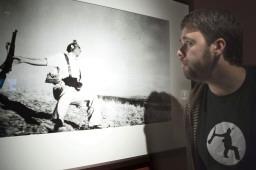A new exhibition here seeks to end a controversy that has dogged a renowned image by one of the world's first photojournalists, Robert Capa, for over 30 years.
The 1936 photograph, which won him worldwide recognition, shows a soldier falling to his death after having just been shot during the Spanish Civil War.
Entitled Loyalist Militiaman at the Moment of Death, but often referred to simply as Falling Soldier, it was first printed in a French publication, Vu, in 1936.
In the summer of 1937 it appeared in Life magazine, whose circulation of 1.6 million guaranteed its visibility and established Capa's reputation permanently.
The image was for many decades considered one of the greatest war photographs ever taken but it was called into question by a British journalist in 1975, who suggested it may have been staged.
Although there was little evidence in support of this claim, most of which was later systematically discredited by Capa's biographer Richard Whelan, the allegations stuck and some doubts still linger today.
The exhibition explains the controversy to visitors and works through the images on Capa's film before and after the photograph to explain why Falling Soldier is genuine.
Backing up the claim of authenticity is a range of shots by a photojournalist working with Capa at the time, Gerda Taro.
Taro, who was Capa's lover, also documented the Spanish Civil War extensively until her death in 1937, and a number of images published under Capa's name were actually her work.
Taro and Capa, who was born Endre Erno Friedmann in Hungary, together created the persona of the fictional US photographer named Robert Capa because they found it easier to sell their work.
After Taro's death, Friedmann kept the name Capa but a number of his early images have been attributed to the Jewish-German Taro, whose work can be distinguished by the different cameras they used.
Although the focus of the exhibit is Capa's work, and in particular Soldier Falling, it also offers visitors a thorough consideration of Taro's own talents, with 200 images and documents on display.
The Capa section of the show covers 300 vintage images, as well as contact sheets, documents and personal letters providing an insight into the man who helped found the Magnum photo agency.
The exhibition is on at the Forma Centro Internazionale di Fotografia until June 21.










